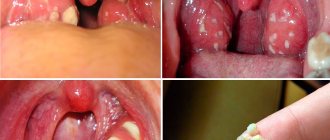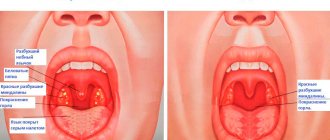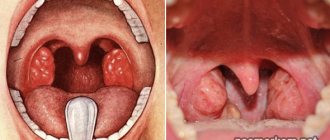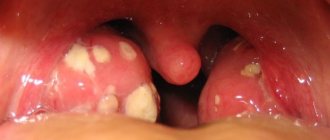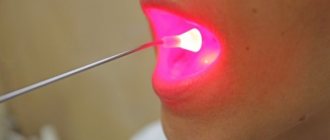What is meant by a loose throat and the reasons for its appearance?
The tonsils and adenoids, found in the oropharynx, are made up of tissue similar to the lymph nodes and glands found in the neck or other parts of the body. Together they form a ring of glandular tissue (Waldeyer's ring) that surrounds the back of the throat:
- Tonsils, or tonsils, are collections of lymphoid tissue in the nasopharynx. Glands are divided into paired and unpaired. The first are located in the back wall of the throat. When healthy, they are pink, just like their environment. On the surfaces of the tonsils there are small depressions called crypts, in which, during inflammatory processes, there may be pockets of pus or tonsil stones.
- Adenoids are enlarged nasopharyngeal glands located high in the throat behind the nose and soft palate. Unlike tonsils, they are difficult to see through the mouth.
It is believed that the tonsils and adenoids protect the body from bacteria and viruses by forming antibodies. However, this function may only be important during the first year of a child's life. According to doctors, there is no evidence confirming the role of these glands in protecting the immune system. When the adenoids are removed, children subsequently remain resistant to preventing infections.
Doctors identify two main causes of a red, inflamed, bumpy throat:
- Viral. Lymphatic tissue provides a favorable breeding ground for microbes that enter the pharynx. The tonsils are the first to meet them and reflect the blow with the production of lymphocytes. In this case, redness of the tissues and nodes occurs, the mucous membrane becomes loose and porous.
- Physiological characteristics of the body. The looseness of the tissue can be constant, which is a hotbed for the development of infections. Swelling and lumpiness can also be the result of allergic reactions to food, medications, cigarette smoke, and dry air.
Viruses that enter the tonsils provoke the development of many diseases:
- ARVI. The appearance of inflammation depends on the type of microorganisms that have penetrated. This could be an adenovirus infection, which is characterized by a loose red throat with a fibrinous coating, an RS infection, or respiratory failure.
- Tonsillitis. With this disease, pockets of pus form, which are visible as white spots on the tonsils.
Tonsillitis can acquire an acute form or become chronic.
Acute development of the pathology is accompanied by pain and associated fever.
Signs of chronic tonsillitis appear when there is a persistent infection of the tonsils. Repeated, frequent diseases lead to the formation of small pockets (crypts) in the tonsils, the contents of which are a source of nutrition for bacteria.
Causes of the pathological condition
Swelling or inflammation of the tonsils is very common, especially in childhood. What does “loose tonsils” mean? A medical specialist cannot answer, since this is the wrong term. The meaning of the term is not defined. Enlarged tonsils are not “loose”. What is permanently “loose” may not be lymphoid accumulations, but sand or earth.
Especially between the ages of 3 and 7, swollen tonsils often occur due to infections and the development of the child's immune system. During puberty, the tonsil copes with the load, so swelling becomes less common. Even a specialist cannot answer exactly why the tonsils are loose.
Tonsil hypertrophy does not always pose a health threat or require treatment. However, if symptoms occur - shortness of breath, difficulty swallowing or middle ear infections - appropriate treatment should always be started. In severe or chronic cases, the tonsils are surgically removed to prevent further discomfort.
Tonsils are part of the human immune system and help protect against infections and other diseases. They consist of lymphatic tissue and contain a large number of leukocytes. Thanks to this, they are able to produce antibodies and protect the body from invading pathogenic microorganisms.
Various infectious diseases - common flu viruses - as well as serious diseases such as HIV infection can cause enlarged tonsils. In the same way, glandular fever can cause swelling and inflammation of the tonsils.
The flu virus may cause loose tonsils
But not only viruses, but also bacteria sometimes cause enlarged tonsils. Tonsillitis can occur acutely or become chronic if, for example, there is a chronic primary disease or the tonsils must become increasingly activated by frequent infections.
Symptoms
The most noticeable symptom of tonsillitis is a sore throat. Other signs of infection include:
- feverish state of the body;
- bad breath;
- sinus congestion and runny nose;
- swollen cervical lymph nodes;
- red, loose, swollen tonsils with a coating of pus;
- difficulty swallowing;
- quiet voice;
- headache;
- sometimes abdominal pain.
See also
How to quickly treat a red throat in an adult and a child at home
Read
A combination of symptoms such as sore throat, sneezing, runny nose, cough, indicates a viral infection of the body, which is cured within two weeks.
If there are no symptoms of an upper respiratory tract infection in the throat, but there is a fever, this indicates a bacterial nature of the infection.
In this case, you should consult a doctor because of the risk of developing streptococcal throat. Incorrect and untimely treatment of chronic tonsillitis leads to complications. They often develop in children between 5 and 15 years of age after an infection in the larynx.
Causes of pathology. Loose tonsils, what does it mean?
When an infection or virus enters the body, many lymphocytes migrate to the affected area. Because of this, the mucous membrane swells, and hyperemia becomes more pronounced.
There are the following reasons why this process occurs:
- sore throat, which is accompanied by an increase in temperature to critical levels, severe pain in the throat and purulent plaque on the tonsils;
- ARVI;
- tonsillitis;
- pharyngitis.
These diseases are accompanied by cough, low-grade fever and malaise. Often one disease turns into another, for example, ARVI appears and after it pharyngitis begins. Complications arise.
With the existing problem of enlarged tonsils, food particles get stuck in loose cavities and fester. Therefore, it is necessary to gargle, otherwise laryngitis may occur or the tonsils will become severely festered.
Diagnostics
Diagnosis of tonsillitis is based on history, physical examination, and test results. If symptoms indicate infection with streptococci, a throat swab is taken for microbiological examination.
If the Epstein-Barr virus, which causes mononucleosis, is suspected of causing tonsillitis, a blood test is performed for this disease.
If necessary, additional results are collected:
- biochemical blood test;
- analysis for rheumatoid factor;
- ECG;
- urological analysis; according to special indications, an ultrasound of the kidneys is performed.
After collecting all the examination results, the doctor makes a diagnosis and prescribes treatment.
Treatment program
The treatment methods used for loose tonsils directly depend on the age and severity of the pathology.
At the initial examination, the doctor prescribes a laboratory test of the scraping to determine the sensitivity of the flora.
Only after the type of pathogenic pathogen has been established is the necessary therapy prescribed.
If the growth in the tonsils passes without signs of acute inflammation, preventive measures are recommended:
- Frequent ventilation is required.
- Rinse and moisturize the nasal and oral cavities.
- Hardening.
- Active physical education in the fresh air, outdoor games
- Vitamin therapy.
For inflamed tonsils, a course of physiotherapy is prescribed (10 days - 2 weeks). This can be ultrasound, herbal medicine, oil and alkaline inhalations, laser treatment. After active exposure, when the inflammation has passed, the tonsils return to their normal size and are smoothed out.
At home, rinsing with furatsilin, chamomile, sage, calendula, and saline solutions is recommended for a month. Hardening the throat is useful. It begins with rinsing with cool water, with a gradual decrease in temperature. To acclimate the tonsils to the cold, it is recommended to suck on small ice cubes.
In unusual cases that are difficult to treat conservatively, cauterization with silver nitrate is prescribed.
Removal
When tonsil hypertrophy reaches a large size, it means that there is a mechanical barrier to breathing, swallowing and speech production. In this case, partial excision of two growths is indicated - tonsillotomy.
But this is a last resort. To remove means to open the way for pathogenic microorganisms. In addition, after the procedure, the mucous membrane will tend to dry out, which, in turn, will lead to frequent pharyngitis and discomfort in the throat. Without a protective barrier, pathogens will freely penetrate the bronchi and lungs.
Removal of tonsils is indicated only if the damage to health exceeds their benefit, and the growths become a breeding ground for infection. Surgery is prescribed when inflammation is severe and requires antibacterial treatment more than 4 times a year.
In what cases should you seek help?
A sore throat caused by a viral infection goes away within 6-12 days. If there is no pain when swallowing, weakness, or malaise, but the tonsils are loose, then preventive measures will be sufficient.
If you suspect inflammation of the tonsils, you should consult a doctor. Signs indicating a bacterial infection:
- severe inflammation of the throat;
- problem with swallowing;
- labored breathing;
- difficulty opening the mouth;
- elevated temperature;
- painful and stiff neck;
- Ear ache.
All this together may mean the onset of tonsillitis, which must be treated.
How to recognize?
In medical terminology, there is no “loose tonsils” disease, since this is a sign of a respiratory tract disease that has pronounced symptoms. Normally, the tonsil glands have a light pink color, a smooth surface, and a size that does not extend beyond the edges of the palatal arch. If a person has red tonsils with a white coating, fever, cough, he needs to urgently consult an otolaryngologist for advice. Symptoms appear gradually; most often, enlarged, loose tonsils are diagnosed in patients with chronic tonsillitis or pharyngitis.
Loss of strength in a person is one of the signs of such a pathology.
The manifestations are as follows:
- foul odor from the mouth;
- pain when swallowing of varying intensity;
- prostration;
- apathy;
- migraine;
- breathing problems;
- enlargement of lymph nodes.
Therapy
Treatment of inflamed tonsils in an adult is carried out using physiotherapy: ultrasound, laser, magnetotherapy. The course of treatment is two weeks. Thanks to these procedures, pus is eliminated from the surface of the glands, and recovery occurs much faster.
For viral forms of the disease, washing the tonsils is prescribed to remove purulent plaque. Chronic stones are removed from the surface of the tonsils on an outpatient basis using a blunt probe.
For loose glands, the vacuum method is prescribed. Using a vacuum, pus is pulled from the inflamed surface. This operation helps smooth out the tonsils, after which the lymphoid tissue is restored faster.
Physiotherapeutic procedures should be carried out as an alternative to surgery.
Drug treatment
When treating a bacterial infection, antibiotics of the penicillin group are used. In case of massive enlargement of the tonsils and adenoids, a long course of treatment with antibiotics is carried out. Short-term use of cortisone-related steroids to reduce inflammation also helps in this case.
Along with drugs that inhibit the growth of living cells, antiseptic medications are used.
To prevent recurrence of tonsillitis caused by streptococcus, you will need to complete a full course of treatment for at least 7 days.
For severe, frequently recurring tonsillitis, the doctor will recommend surgery to remove the tonsils.
Folk remedies
If your doctor has diagnosed non-bacterial tonsillitis, then some home remedies can help relieve symptoms and treat a sore throat.
For a sore throat, various solutions are used:
- Gargling with sea water helps clear mucus from the throat. To do this, stir sea salt in a glass of boiled water. Then gargle with the liquid infused for 5 minutes.
- Rinsing with a salt-iodide solution helps. To prepare it, salt is mixed in water and combined with 1-2 drops of iodine or soda. Salt has a bactericidal effect, and iodine and soda help draw out pus.
- Inhalation with still alkaline water.
- Rinsing with decoctions of chamomile, sage, calendula.
- Rinse the throat with Furacilin solution.
- Lozenges and lozenges will help relieve sore throat, dryness and redness in mild forms of the disease.
See also
Instructions for using the drug "Iodinol" for gargling for children and adults, how to dilute
Read
When preparing solutions, doctors recommend gradually reducing the water temperature to cold. This increases local immunity and hardens the throat.
Features of treatment in children
If a red coating appears in the throat, pain, or temperature in the baby, you should immediately contact the clinic. After making an accurate diagnosis, the doctor will prescribe antibacterial and anti-inflammatory drugs, which should be taken in the specified dosage. You cannot prescribe broad-spectrum antibiotics yourself. Medicines must exactly match the bacteria that attacked the child’s body.
Physiotherapeutic procedures are a chance for a cure without resorting to the surgical method. For children, procedures such as ultraviolet light, ultrasound, and laser therapy are used.
To soothe pain and relieve redness, you can use lozenges, which should be plant-based and not contain chemical additives.
At home, you need to teach your child to gargle. If he is not allergic to foods and herbs, then you can gargle with plant decoctions. Saline and soda solutions are best for children, as well as rinsing with sea water.
Main features
As already mentioned, the tonsils become loose due to inflammation. But this is not a disease. Therefore, there are no specific symptoms, there may only be accompanying signs. So, the inflammatory process in the tonsils is characterized by:
- Bad breath. Why does he appear? The fact is that food is retained in small quantities on enlarged and loose tonsils. Then it decomposes, hence the unpleasant smell. Constant gargling is recommended to disinfect and flush out decomposed food particles. Otherwise, the inflammatory process will spread to the larynx and the person will get laryngitis.
- Sore throat. These unpleasant sensations most often occur when swallowing; they are provoked by the inflammatory process.
- Increased body temperature. But it does not necessarily rise to too high levels. Sometimes it is within normal limits, sometimes it is low-grade. A sharp increase in temperature indicates the development of a sore throat.
- Headache. Headache is caused by swelling of the mucous membrane, difficulty breathing, and general weakness of the body.
- Weakness, lethargy. Due to infection, the body becomes weakened. With severe nasal congestion, breathing may be difficult, then the person eats poorly and sleeps little. This leads to lethargy, fatigue, and weakness. Children are often capricious.
- Enlarged lymph nodes. With the proliferation of lymphoid tissue, enlargement and inflammation occur in the nearest lymph nodes. If you palpate, they can be felt better, become much larger in size and painful.
- Special appearance. If you look into a healthy human throat, you can see tonsils with a smooth, even and pinkish surface. And if you examine an inflamed throat with loose tonsils, you will notice that the throat has become red and the surface of the larynx has become uneven. The tonsils become covered with red or yellowish bumps; these are places of suppuration. They are covered with a white-yellow coating.
All of these symptoms that relate to loose tonsils do not have to occur at the same time. As a rule, one or two are enough to understand that inflammation has begun.
If there is a suspicion of tonsil disease, body temperature has risen, a sore throat appears when swallowing, and plaque has been noticed, you should consult a doctor for help as soon as possible. He will prescribe immediate treatment.
Forecast
Tonsillitis is not a complex disease. The main thing is to notice the approaching disease in time and take precautions. If some symptoms continue for more than 4 days and no improvement is seen, you should see a doctor.
Complications after an illness are more likely to occur if the infection is caused by a bacterial infection. Possible complications:
- middle ear infections;
- tonsillitis (peritonsillar abscess);
- obstructive sleep apnea, where the walls of the throat relax, causing difficulty breathing and poor sleep;
- scarlet fever;
- rheumatic fever.
Preventive measures and prognosis
The prognosis of even excessively enlarged tonsils is usually positive. Most of the time there is no major discomfort and the tonsils do not need to be removed. If treatment is necessary, it usually takes place without serious complications.
Enlarged tonsils are removed under general anesthesia, and the patient can leave the hospital immediately after the procedure. A hospital stay is only required for certain pre-existing conditions - bleeding disorders or simultaneous removal of tonsils. Only typical complications such as bleeding or pain when swallowing can slow the healing process to a minimum.
If enlarged tonsils are left untreated, symptoms such as middle ear infections or even severe respiratory illness may occur. Rarely there are disorders of language development, which, in turn, require therapy. The outlook and prognosis are therefore good, but also depend on the size of the tonsils, the timing of treatment and the patient's physique.
Enlarged tonsils cannot always be prevented as they are usually caused by viral or bacterial infections. An overall strengthening of the immune system, however, may help fight off pathogens faster and better, which also makes tonsillitis less common and reduces symptoms.
A healthy lifestyle supports the immune system and also improves the general condition of the patient. If the first symptoms appear, especially children, it should be brought to the attention of a doctor as a precaution so that he can begin appropriate therapy. If complications occur in an adult, you should consult your doctor if symptoms are severe or last longer than usual.
Loose tonsils in a 2 year old child
Loose tonsil
my son is 5 years old in the summer, I sent him to kindergarten, he didn’t go to kindergarten for long and got sick, we had a month after that, the tonsils became enlarged and loose but not swollen, Kirill and I went to the ENT specialist, but the ENT specialist said that the tonsils are normal, they are average and there is nothing wrong, and prescribed IRS 19 to spray in the mouth and nose for three months.
I see that my son’s tonsils were smaller, please tell me, you wrote that such tonsils can simply be washed and they will be normal? Can I wash my tonsils? Hello! My middle child is 3 years 2 months old. He has loose tonsils and has difficulty breathing at night. What should we do? How to help a child?
Hello Ivan Vasilyevich, my name is Anna, my daughter is 6 years old. Since early childhood we have been suffering from a sore throat, usually a red throat, a temperature of 39, we used to have a cough and sputum, but now it’s mostly just a fever and a red throat. At 2.5 we had our adenoids removed and part of our tonsils cut off, the doctor said that we won’t get sick again We will, but over time the tonsils have grown again, I myself see that they are large and loose. We are diagnosed with: chronic tonsillitis, chronic pharyngitis, tonsillitis often. The situation becomes even more complicated.
Hello, doctor! My son is 4 years 8 months old. From a very early age, he often suffered from sore throats, the doctor said that this was due to loose tonsils. He prescribed us Ribomunil, we took one course, the pain seemed to be less.. And a year ago we noticed that that my son began to snore and sniffle at night, it’s hard to breathe through his nose, especially at night. The nose is constantly dry, only after going outside it gets moisturized. At home we often irrigate with saline solution or Aqualor. In general, we recently visited the ENT specialist again - he said that they are so loose tonsils are better.
Hello. My son is 2.8 years old and he constantly has loose and huge tonsils. It has gotten to the point where he snores like an old man at night. I had a sore throat, but the ENT doctor did not recommend cutting them out. Now we are being treated with the traditional method, at night I put a compress of potatoes, honey and vodka, they became a little smoother and not so big, I can’t rinse, he just drinks water and that’s it, go to the doctor for rinsing.
It won’t work either, because my son will cry hysterically and won’t open his mouth. Recommend how.
How to treat a child's sore throat
A sore throat is medically associated with chronic tonsillitis. The use of the term is appropriate when, upon examination, a large amount of lymphoid tissue is found in the child’s throat. The tonsils, which are located on the back wall of the pharynx, are covered with lymphoid follicles, as a result of which they become loose.
A sore throat develops if a child often has a sore throat. When this diagnosis is made, the doctor prescribes an appropriate course of treatment.
Content
Features of the disease
The tonsils are a kind of barrier. It is part of the immune system that fights pathogens.
Tonsils consist of lymphoid tissue, which performs the function of hematopoiesis. Lymphocytes are directly related to immunity. The infection enters the body through airborne droplets. When this happens, white blood cells become activated. They begin to fight bacteria, destroy them, as a result of which the tonsils become inflamed.
If a child often suffers from tonsillitis, the structure of the tonsils begins to deteriorate and a loose throat develops. The situation is aggravated by the presence of carious teeth in the oral cavity, poor personal hygiene, chronic inflammation of the nose and pharynx, and frequent colds.
The disease is accompanied by pain when swallowing, frequent fatigue, and headaches. A child may often have a temperature of up to 37.5 degrees. When the process worsens, disturbances in the functioning of the excretory, cardiovascular, and nervous systems are observed.
With chronic tonsillitis, the danger to the child’s health is that the tonsils are no longer a barrier that protects the body. They themselves represent the source of infection. The child’s immune system weakens; complications can develop at any time, which affect other systems of the body.
Symptoms
A loose throat in children with chronic tonsillitis is often found. Usually the cause is incorrect or untimely treatment of a child with sore throat. The acute form of the disease is easier to treat with antibiotics. If the disease has become chronic and the child has a loose throat, then treatment often ends with surgery.
With chronic tonsillitis, the clinical picture is typical. For specialists, the symptoms do not cause diagnostic difficulties:
- sore throat
- body temperature can rise sharply from subfebrile to hyperthermic
- headache
- general weakness
- an increase in the size of the tonsillar lymph nodes.
- soft sky
- hyperthermia and swelling of the tonsils
- the presence of pus in the lacunae of the tonsils
- the presence of a white-yellow coating.
For diagnostic purposes, pharyngoscopy may be prescribed. With tonsillitis, the picture is typical:
Treatment is prescribed only after a microbiological examination of a smear. This allows you to determine the sensitivity of bacteria to antibiotics that multiply on the tonsils.
Treatment
The traditional method of therapy is used more often. For inflammation of the tonsils, treatment is provided with antibacterial drugs. Usually the doctor prescribes aminopenicillins with clavulanic acid.
Beta-hemolytic streptococcus belongs to a group of pathogenic microorganisms that cause acute inflammation of the tonsils. In this case, synthetic penicillins have their role. Treatment is also carried out with cephalosporin antibiotics. These drugs are cefadroxil, cefaclor, axetil.
Antiseptics are used along with antibiotics. They cause analgesic and anti-inflammatory effects. Treatment is carried out using stopangin, hexoral, tantum verde.
Physiotherapeutic procedures
Physiotherapeutic techniques are considered an alternative to surgery. To perform a tonsillotomy, the doctor's indications must be significant. Removal of the tonsils is carried out when other body systems begin to suffer from the disease, but no other method of therapy is effective.
Rinsing
A saline solution is used for rinsing. You can prepare it at home. To do this, take one teaspoon of table salt and dilute it in a glass of water. Then add a small amount of soda or iodine. Salt has a bactericidal effect. Iodine or soda helps remove pus from the tonsils.
Calendula has an astringent and antibacterial effect. To prepare the solution, you need to dilute one tablespoon of calendula in a glass of water. Rinsing can be done up to 10 times a day, depending on the severity of the disease.
Prevention
If a child is susceptible to diseases of the ENT organs, prevention should be an integral part of his lifestyle. The goal of prevention is to prevent immunity from decreasing to a level where the risk of developing infection is high.
It is necessary to maintain personal oral hygiene. Pathogenic bacteria can multiply on teeth and tongue. You can carry out preventive rinses with antiseptic solutions.
Sometimes experts recommend regular visits to an otolaryngologist for the purpose of preventive rinsing of palatal lacunae. If it is not possible to visit a doctor, you can rinse at home. To do this, use a solution of furatsilin. It has a detrimental effect on streptococci and staphylococci - microorganisms that cause the development of inflammation of the lymphoid tissue of the tonsils.
Medication solutions can be alternated with herbal decoctions. For rinsing, you can use a decoction of chamomile, sage, and calendula. It is recommended to carry out rinsing procedures for a month. Then you can take a break for the same period of time.
Your review/rating:
5 Please rate the article
Content:
As you know, the immune system is responsible for protecting human health. Children acquire most pathogenic bacteria through inhaled air, food and drink. The first line of defense is located precisely in this zone of microbial attack - in the mouth and nasopharynx - and consists of six tonsils: palatine, tubal, pharyngeal and lingual. Their cluster is called Pirogov's ring.
The complex structure of the amygdala determines its filtering function. Around the branched narrow tubules - lacunae - extending into the organ, there are lymphatic follicles that produce special immune cells capable of destroying pathogens.
In addition to the protective function, these small organs also perform a hematopoietic function. However, when the immune system is weakened, the tonsils themselves become victims of infection and at this stage begin to pose a danger to the child’s body. At the same time, the tonsils lose their original barrier functions. Affected by dangerous microorganisms, they increase in size, become inflamed and hypertrophy.
Treatment in children
The fight is advisable in case of inflammation in early childhood. The immune system of a child from three to five to ten years of age is just developing and developing. The pharyngeal and palatine tonsils are most often affected. If inflamed tonsils are observed in a child, treatment is prescribed when the following symptoms are detected:
- fever and rhinitis (runny nose)
- tonsils are enlarged and have a red or bright pink color
- white plaque that accumulates on the surface of the tonsils
- intense painful sensations that make swallowing difficult. The pain is localized in the tonsils.
Symptoms begin to appear three days after the infection enters the child's body. Acute inflammation is called tonsillitis. A predisposition to this disease is reduced immunity, especially in combination with hypothermia. Often, inflammation disrupts the structure of the tonsil, making it loose.
Fight against looseness
If loose tonsils are detected in a child, treatment must be carried out correctly, since the disturbed structure of this organ leads to functional disorders in the body. In such an amygdala, food debris can get stuck and decompose. The most adequate procedures in this case will be rinsing the throat and massaging with a cotton ball. soaked in a medicinal solution. In a clinical setting, ultrasonic cleaning of loose tonsils is carried out in order to remove food debris, pus and bacteria from them.
When examining a child, the doctor determines the stage of tonsil enlargement and, based on the test results, prescribes a course of antimicrobial drugs. In extreme cases, the doctor suggests hospitalization. In addition, the treatment is complemented by other procedures: gargling with antiseptic solutions, the use of immunomodulatory drugs and vitamins.
Treatment of enlarged tonsils in a child
Sometimes such a moment can be detected without symptoms of inflammation, in which case experts talk about hypertrophy of the palatine or pharyngeal tonsils. In this case, signs such as discomfort when swallowing, speech changes, and sensations of fullness in the nasopharynx are observed. In some cases, breathing through the mouth may be difficult.
Frequent colds suffered by a child and a weak immune system contribute to the proliferation of tonsils. Treatment is not carried out if the enlargement of the tonsils does not provoke functional disorders. This is usually the first degree of hypertrophy.
Tonsil hypertrophy in children: treatment
The fight against the disease at the first stage is limited to the controlled stay of the child outside during the cold season. Parents should teach their children to breathe through their nose and monitor the temperature of the food and drinks the child eats - extremes are unacceptable.
The second degree of hypertrophy is characterized by two-thirds filling of the pharyngeal cavity with overgrown tissues of the tonsils. In this case, preventive treatment in the form of using antiseptic sprays and gargling after meals and before bed is sufficient. The best rinses are decoctions of chamomile, sage and mint. Lubricating the tonsils with a mixture of three parts honey and one part aloe juice relieves symptoms well.
The most severe stage - the third stage without inflammatory enlargement of the tonsils - requires medical supervision of the child and monitoring of his condition. In this case, the hypertrophied tonsils move significantly closer to the palatine arch and can completely close, thereby making it difficult for the child to breathe and swallow. If this situation persists for a long time, the doctor prescribes surgical removal.
You should know that treating tonsils in children in this way can only be used as a last resort. Removal deprives the child’s body of reliable protection against the penetration of bacteria and viruses through the larynx. Typically, after puberty, the tonsils atrophy, returning to normal size.
The external environment always poses a threat to children's health. The tonsils are the first to take the blow. Attentive attention to the condition of these small but important formations will allow timely detection and proper treatment of any pathology.
Enlarged tonsils in a child: how to alleviate the suffering of your child?
The health of the child is the most important value in the life of parents. At birth, a little person is already able to resist various provoking factors and pathogenic microorganisms. The immune system is a powerful barrier on which the further introduction of external irritants into the body depends, and the tonsils (tonsils) are the gateway to infection and viruses.
Their increase or proliferation indicates some kind of malfunction of the immune system and informs about inflammatory processes in the lymphoid tissue. Redness appears in the larynx, and the tonsils begin to hypertrophy. Such transformations are very common in childhood. They interfere with nasal breathing, normal articulation, and frequent sore throats do not allow full development.
Tonsillitis is an inflammation of the lymphoid tissue of the palatine tonsils. The pathology can be acute or take a latent form. Often, exacerbations of sore throat are observed in the cold season. Parents also attribute the disease to other factors: eating ice cream, drinking cold lemonade, swallowing frosty air. But there is one problem - decreased immunity.
If parents harden their child from birth, then it is much easier for him to cope with viruses and various pathogenic agents that are to blame for the occurrence of tonsillitis. The chronic form of sore throat is very insidious. Already in adulthood, it can result in heart problems and arthritis.
Symptoms of tonsillitis
If a child is sick regularly, then it is not difficult for his family to understand what is happening. Signs of inflammation are:
- enlarged tonsils
- severe pain when swallowing
- sleep and eating disorders
- elevated body temperature up to 38-40 degrees
- general intoxication of the body
- irritation
- coughing up pus plugs
- bad breath
- lethargy
It is necessary to immediately consult a doctor and examine the child’s inflamed tonsils, treatment of which will need to begin immediately.
Therapy for tonsillitis varies and depends on the form of the disease and the duration of the process. The results of culture and blood tests can tell a lot, and the otolaryngologist will be able to make an accurate diagnosis and prescribe treatment. The principle of treatment for sore throat is to neutralize the pathogen, remove inflammation and activate immune processes, however, the treatment of lacunar, catarrhal and follicular tonsillitis is somewhat different.
Diagnosis of tonsillitis
Identifying and confirming inflammation is not that difficult. An ENT doctor only needs to examine the patient to detect enlarged and loose tonsils in the child, treatment of which must be started urgently.
But the specialist must prescribe laboratory and bacteriological tests. Based on medical history, objective symptoms and test results, a diagnosis is made indicating the form and course of the disease.
Enlarged tonsils in a child: treatment with traditional methods
Often, mothers whose children suffer from this disease from time to time already know all the intricacies of treatment very well. They know which medications are suitable for the child, and also successfully learn from the experience of their friends. However, this is not always safe. Self-medication can harm the baby if you do not examine him completely and do not ask a doctor for advice. The therapeutic complex of procedures is aimed at destroying painful microflora, improving the discharge of contents, and increasing the immune balance of the body.
Conservative treatment of acute tonsillitis includes:
- Antibacterial therapy
- Taking immunostimulating drugs
- Rinsing and lubricating tonsils with antiseptics
- Physiotherapeutic procedures
- Vitamin therapy
- Dry heat
- Warm drink
One of the prerequisites for recovery is maintaining bed rest and alkaline drinking. Antihistamines are used to relieve swelling. The child's diet should include warm pureed food. It should be remembered that without proper treatment, the pathology will take a chronic form and will recur. The course of such therapy should be complete and not stop at the first signs of improvement. Conservative therapy for tonsillitis may be appropriate only in cases where removal of the tonsils is not possible for health reasons, and if the child is bothered by minor local manifestations of tonsillitis.
Indications for surgical measures
Naturally, removing tonsils is easier than regularly dealing with chronic inflammation. However, this decision must be made by the doctor, weighing the pros and cons. Tonsils are powerful defenders of the body against infection, so their absence can have a negative impact on the baby’s health in the future.
When to think about surgery:
Prevention
Measures to prevent the occurrence of the disease should be aimed at maintaining immunity, maintaining a healthy lifestyle, and keeping the body healthy. For preventive purposes, the elimination of all potential foci of infection is indicated: caries teeth, adenoids and other diseases of the ENT organs.
Sources: bticino.com.ru, lecheniedetej.ru, lechenierebenka.ru, med88.ru
Next articles:
Scarlet fever
With scarlet fever in children, enlarged tonsils and a sore throat are combined with a characteristic rash. The rash is pinpointed, with a background of redness. It is usually located on the flexor surfaces of the limbs and in the natural folds of the skin. The nasolabial triangle is clean.
On an outpatient basis, amoxicillin is prescribed at a rate of 30-60 mg/kg per day. In the hospital, for severe forms, benzylpenicillin is prescribed 50,000-100,000 units/day for 4-6 injections. The reserve antibiotic is clindamycin. Antipyretics are used as symptomatic treatment: paracetamol and ibuprofen are the drugs of choice. Paracetamol is prescribed in a single dose of 10–15 mg/kg no more than 4 times a day with an interval of at least 4 hours, ibuprofen is prescribed in a single dose of 5–10 mg/kg 3–4 times a day. Local treatment of tonsillitis is the same as for classic streptococcal sore throat.
When to treat hypertrophy of the tonsils
It is considered normal if the surface of the tonsils does not protrude beyond the edge of the palatine arch. Enlarged tonsils are divided into three categories:
- 1st degree - when lymphoid tissue occupies a third of the space from the palatine arch to the imaginary midline of the pharynx;
- 2nd degree – increase to two-thirds of the space;
- 3rd degree – completely block the free space of the pharynx.
Treatment of 1st degree hypertrophy of the tonsils
Enlarged tonsils of the 1st degree do not need to be treated if this is the only sign of an active immune process without inflammation. If the child’s palatine arches are not inflamed, the surface of the tonsils is pink and without plaque, then it is enough to periodically gargle with antiseptic solutions - furatsilin or miramistin. Using a good toothpaste that contains anti-inflammatory components helps to avoid inflammation of the tonsils. By the age of 25, grade 1 hypertrophy of the tonsils without the addition of chronic infections disappears without treatment.
To prevent inflammation of moderately hypertrophied glands, the mother needs:
- ensure that the child always has clean nasal passages;
- promptly treat inflammation of the nasal mucosa;
- understand that if the throat is red, then this is already a sign of impending inflammation.
Difficulty nasal breathing leads to the fact that the baby's mouth is constantly open. This causes drying of the mucous membranes of the mouth, hypothermia of the tonsils and contamination with bacteria. All these factors inevitably lead to the development of tonsillitis.
Treatment of 2nd and 3rd degree hypertrophy of the glands
When the increase reaches the second or third degree, this means that the child’s immunity cannot cope with the effects of environmental factors. Hypertrophied tonsils cause a number of disorders in the children's body.
- Free breathing is impaired. This is especially noticeable during night or daytime sleep. The child sleeps superficially, reacting sensitively to even minor noise. After such inadequate rest, he becomes irritable, moody, and his appetite decreases. A characteristic sign of enlarged tonsils is snoring during sleep.
- A constant lack of oxygen due to breathing problems can lead to children being retarded in both physical and mental development. The child gets tired quickly and does not assimilate the material well. Many children with enlarged tonsils may develop enuresis (incontinence while sleeping).
- Large tonsils make it difficult to swallow food and liquids normally. While eating, the child may choke or have bouts of vomiting for no apparent reason.
- Hypertrophy of the glands causes frequent colds. With the development of chronic tonsillitis, the child is at risk of complications on the heart and joints. Almost all patients with rheumatism have a history of grade 2-3 enlarged tonsils.
Children with grade 2 and 3 enlarged palatine tonsils should be followed up by an ENT specialist.
